Analyzing Customer Experience in the Service Sector: Unit 2 Report
VerifiedAdded on 2023/01/04
|11
|2868
|99
Report
AI Summary
This report provides a comprehensive analysis of customer experience management within the service sector, using the Bancone restaurant as a case study. It begins by examining the importance of understanding the needs and wants of the target audience, focusing on psychographic segmentation and its impact on strategy development and customer engagement. The report then discusses various factors influencing customer engagement across different target customer groups, such as old age people, business class, and adults. A customer experience map is developed to illustrate the customer journey, from website interaction to online/offline reviews. Customer touchpoints, including before, during, and after-purchase interactions, are explained, highlighting how they create business opportunities. Finally, the report critically analyzes the role of digital technology and CRM systems in managing customer experience within the service sector, offering examples of how these tools are employed to enhance customer relationships and drive business success. The report concludes by summarizing the key findings and recommendations for improving customer experience.

Unit 2 - Managing
Customer Experience
Customer Experience
Paraphrase This Document
Need a fresh take? Get an instant paraphrase of this document with our AI Paraphraser
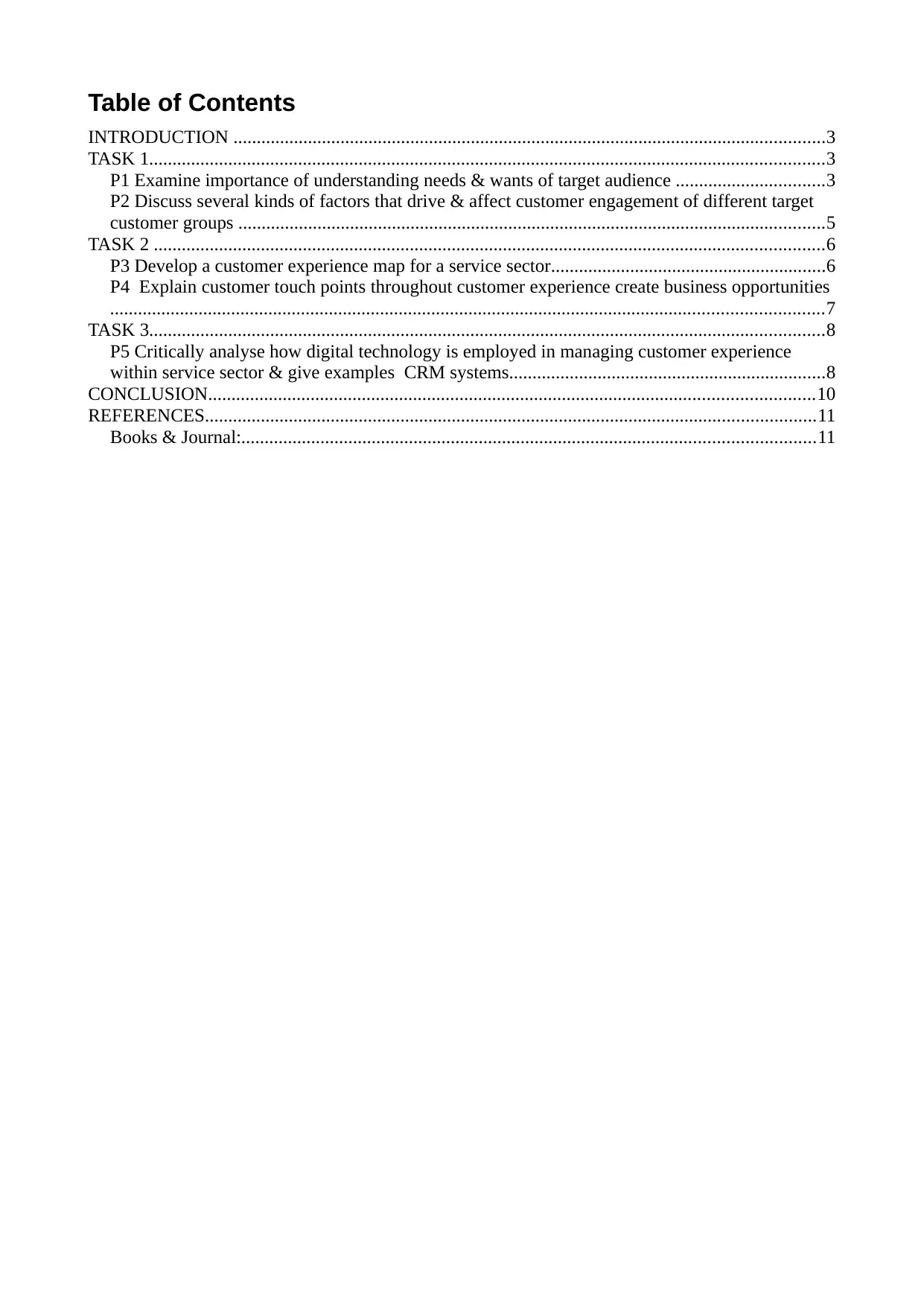
Table of Contents
INTRODUCTION ...............................................................................................................................3
TASK 1.................................................................................................................................................3
P1 Examine importance of understanding needs & wants of target audience ................................3
P2 Discuss several kinds of factors that drive & affect customer engagement of different target
customer groups ..............................................................................................................................5
TASK 2 ................................................................................................................................................6
P3 Develop a customer experience map for a service sector...........................................................6
P4 Explain customer touch points throughout customer experience create business opportunities
.........................................................................................................................................................7
TASK 3.................................................................................................................................................8
P5 Critically analyse how digital technology is employed in managing customer experience
within service sector & give examples CRM systems....................................................................8
CONCLUSION..................................................................................................................................10
REFERENCES...................................................................................................................................11
Books & Journal:...........................................................................................................................11
INTRODUCTION ...............................................................................................................................3
TASK 1.................................................................................................................................................3
P1 Examine importance of understanding needs & wants of target audience ................................3
P2 Discuss several kinds of factors that drive & affect customer engagement of different target
customer groups ..............................................................................................................................5
TASK 2 ................................................................................................................................................6
P3 Develop a customer experience map for a service sector...........................................................6
P4 Explain customer touch points throughout customer experience create business opportunities
.........................................................................................................................................................7
TASK 3.................................................................................................................................................8
P5 Critically analyse how digital technology is employed in managing customer experience
within service sector & give examples CRM systems....................................................................8
CONCLUSION..................................................................................................................................10
REFERENCES...................................................................................................................................11
Books & Journal:...........................................................................................................................11
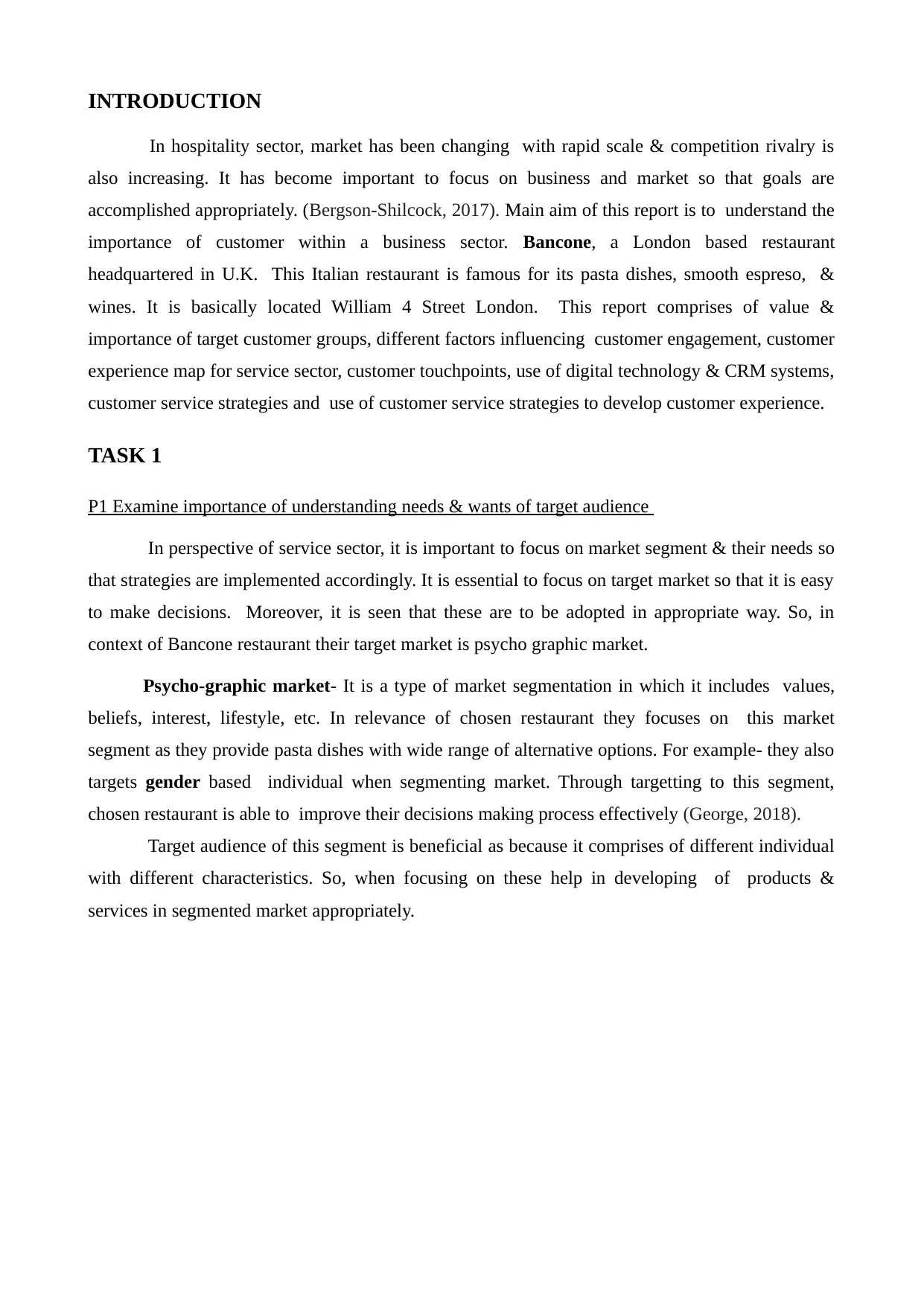
INTRODUCTION
In hospitality sector, market has been changing with rapid scale & competition rivalry is
also increasing. It has become important to focus on business and market so that goals are
accomplished appropriately. (Bergson-Shilcock, 2017). Main aim of this report is to understand the
importance of customer within a business sector. Bancone, a London based restaurant
headquartered in U.K. This Italian restaurant is famous for its pasta dishes, smooth espreso, &
wines. It is basically located William 4 Street London. This report comprises of value &
importance of target customer groups, different factors influencing customer engagement, customer
experience map for service sector, customer touchpoints, use of digital technology & CRM systems,
customer service strategies and use of customer service strategies to develop customer experience.
TASK 1
P1 Examine importance of understanding needs & wants of target audience
In perspective of service sector, it is important to focus on market segment & their needs so
that strategies are implemented accordingly. It is essential to focus on target market so that it is easy
to make decisions. Moreover, it is seen that these are to be adopted in appropriate way. So, in
context of Bancone restaurant their target market is psycho graphic market.
Psycho-graphic market- It is a type of market segmentation in which it includes values,
beliefs, interest, lifestyle, etc. In relevance of chosen restaurant they focuses on this market
segment as they provide pasta dishes with wide range of alternative options. For example- they also
targets gender based individual when segmenting market. Through targetting to this segment,
chosen restaurant is able to improve their decisions making process effectively (George, 2018).
Target audience of this segment is beneficial as because it comprises of different individual
with different characteristics. So, when focusing on these help in developing of products &
services in segmented market appropriately.
In hospitality sector, market has been changing with rapid scale & competition rivalry is
also increasing. It has become important to focus on business and market so that goals are
accomplished appropriately. (Bergson-Shilcock, 2017). Main aim of this report is to understand the
importance of customer within a business sector. Bancone, a London based restaurant
headquartered in U.K. This Italian restaurant is famous for its pasta dishes, smooth espreso, &
wines. It is basically located William 4 Street London. This report comprises of value &
importance of target customer groups, different factors influencing customer engagement, customer
experience map for service sector, customer touchpoints, use of digital technology & CRM systems,
customer service strategies and use of customer service strategies to develop customer experience.
TASK 1
P1 Examine importance of understanding needs & wants of target audience
In perspective of service sector, it is important to focus on market segment & their needs so
that strategies are implemented accordingly. It is essential to focus on target market so that it is easy
to make decisions. Moreover, it is seen that these are to be adopted in appropriate way. So, in
context of Bancone restaurant their target market is psycho graphic market.
Psycho-graphic market- It is a type of market segmentation in which it includes values,
beliefs, interest, lifestyle, etc. In relevance of chosen restaurant they focuses on this market
segment as they provide pasta dishes with wide range of alternative options. For example- they also
targets gender based individual when segmenting market. Through targetting to this segment,
chosen restaurant is able to improve their decisions making process effectively (George, 2018).
Target audience of this segment is beneficial as because it comprises of different individual
with different characteristics. So, when focusing on these help in developing of products &
services in segmented market appropriately.
⊘ This is a preview!⊘
Do you want full access?
Subscribe today to unlock all pages.

Trusted by 1+ million students worldwide
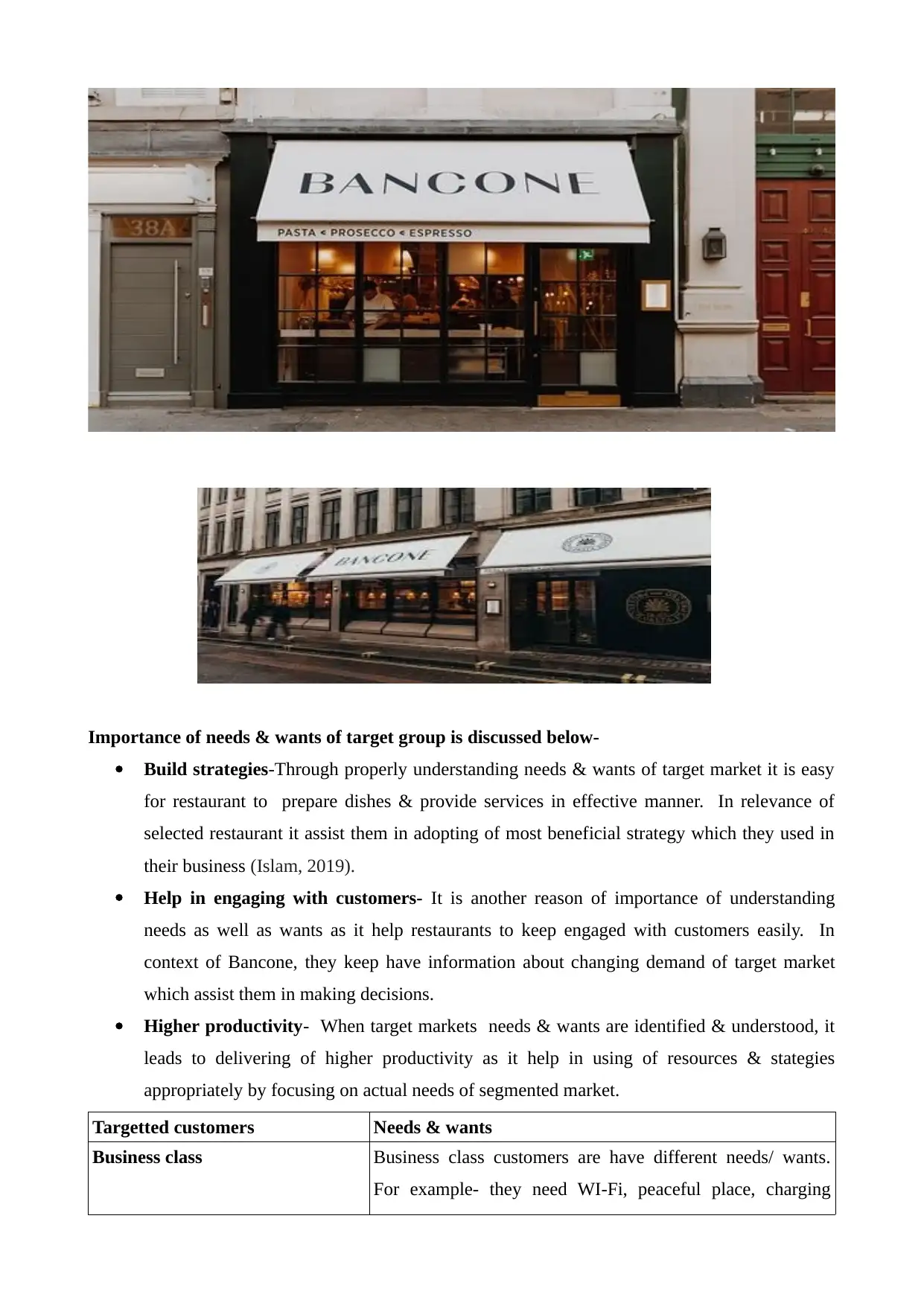
Importance of needs & wants of target group is discussed below-
Build strategies-Through properly understanding needs & wants of target market it is easy
for restaurant to prepare dishes & provide services in effective manner. In relevance of
selected restaurant it assist them in adopting of most beneficial strategy which they used in
their business (Islam, 2019).
Help in engaging with customers- It is another reason of importance of understanding
needs as well as wants as it help restaurants to keep engaged with customers easily. In
context of Bancone, they keep have information about changing demand of target market
which assist them in making decisions.
Higher productivity- When target markets needs & wants are identified & understood, it
leads to delivering of higher productivity as it help in using of resources & stategies
appropriately by focusing on actual needs of segmented market.
Targetted customers Needs & wants
Business class Business class customers are have different needs/ wants.
For example- they need WI-Fi, peaceful place, charging
Build strategies-Through properly understanding needs & wants of target market it is easy
for restaurant to prepare dishes & provide services in effective manner. In relevance of
selected restaurant it assist them in adopting of most beneficial strategy which they used in
their business (Islam, 2019).
Help in engaging with customers- It is another reason of importance of understanding
needs as well as wants as it help restaurants to keep engaged with customers easily. In
context of Bancone, they keep have information about changing demand of target market
which assist them in making decisions.
Higher productivity- When target markets needs & wants are identified & understood, it
leads to delivering of higher productivity as it help in using of resources & stategies
appropriately by focusing on actual needs of segmented market.
Targetted customers Needs & wants
Business class Business class customers are have different needs/ wants.
For example- they need WI-Fi, peaceful place, charging
Paraphrase This Document
Need a fresh take? Get an instant paraphrase of this document with our AI Paraphraser
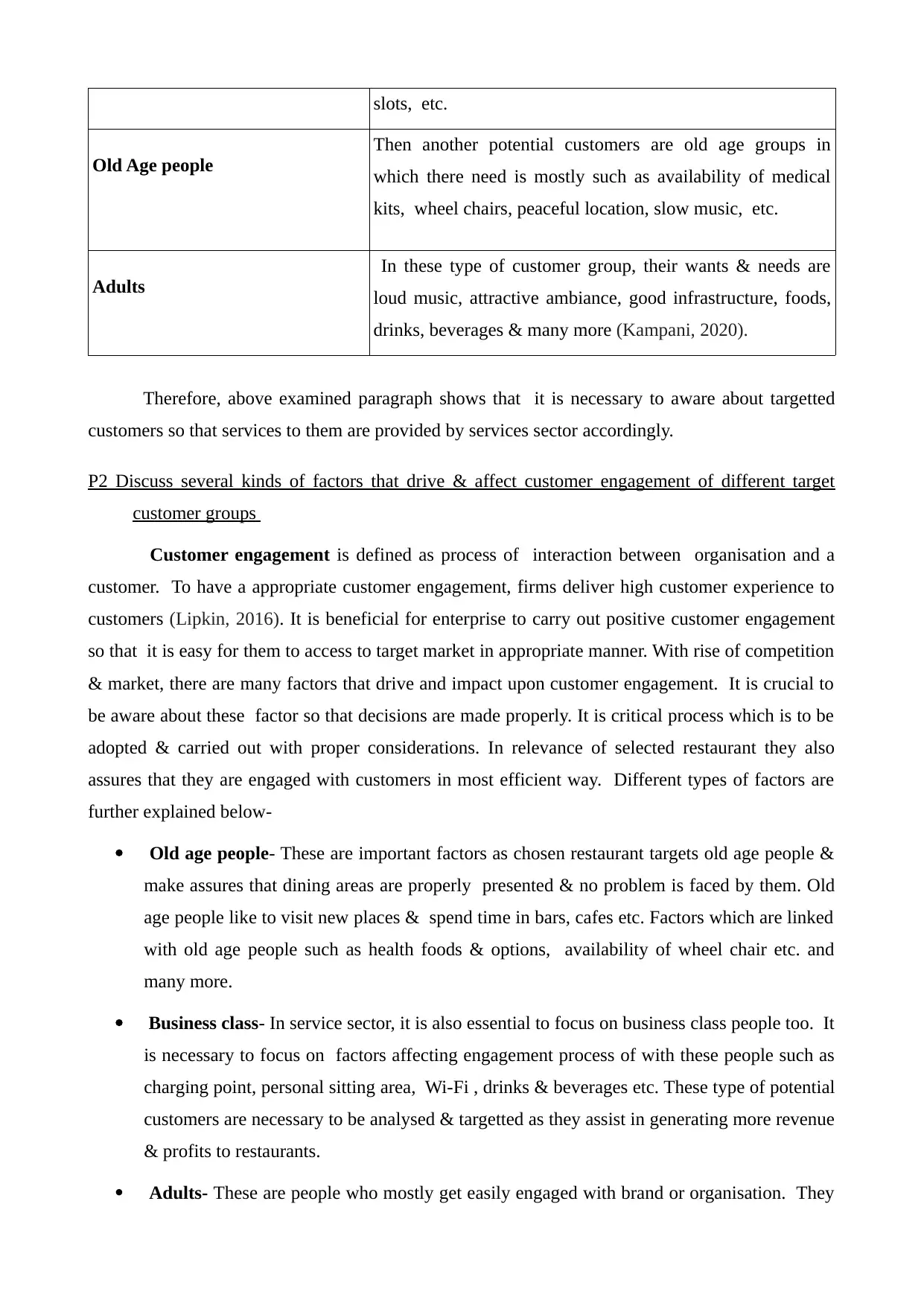
slots, etc.
Old Age people
Then another potential customers are old age groups in
which there need is mostly such as availability of medical
kits, wheel chairs, peaceful location, slow music, etc.
Adults
In these type of customer group, their wants & needs are
loud music, attractive ambiance, good infrastructure, foods,
drinks, beverages & many more (Kampani, 2020).
Therefore, above examined paragraph shows that it is necessary to aware about targetted
customers so that services to them are provided by services sector accordingly.
P2 Discuss several kinds of factors that drive & affect customer engagement of different target
customer groups
Customer engagement is defined as process of interaction between organisation and a
customer. To have a appropriate customer engagement, firms deliver high customer experience to
customers (Lipkin, 2016). It is beneficial for enterprise to carry out positive customer engagement
so that it is easy for them to access to target market in appropriate manner. With rise of competition
& market, there are many factors that drive and impact upon customer engagement. It is crucial to
be aware about these factor so that decisions are made properly. It is critical process which is to be
adopted & carried out with proper considerations. In relevance of selected restaurant they also
assures that they are engaged with customers in most efficient way. Different types of factors are
further explained below-
Old age people- These are important factors as chosen restaurant targets old age people &
make assures that dining areas are properly presented & no problem is faced by them. Old
age people like to visit new places & spend time in bars, cafes etc. Factors which are linked
with old age people such as health foods & options, availability of wheel chair etc. and
many more.
Business class- In service sector, it is also essential to focus on business class people too. It
is necessary to focus on factors affecting engagement process of with these people such as
charging point, personal sitting area, Wi-Fi , drinks & beverages etc. These type of potential
customers are necessary to be analysed & targetted as they assist in generating more revenue
& profits to restaurants.
Adults- These are people who mostly get easily engaged with brand or organisation. They
Old Age people
Then another potential customers are old age groups in
which there need is mostly such as availability of medical
kits, wheel chairs, peaceful location, slow music, etc.
Adults
In these type of customer group, their wants & needs are
loud music, attractive ambiance, good infrastructure, foods,
drinks, beverages & many more (Kampani, 2020).
Therefore, above examined paragraph shows that it is necessary to aware about targetted
customers so that services to them are provided by services sector accordingly.
P2 Discuss several kinds of factors that drive & affect customer engagement of different target
customer groups
Customer engagement is defined as process of interaction between organisation and a
customer. To have a appropriate customer engagement, firms deliver high customer experience to
customers (Lipkin, 2016). It is beneficial for enterprise to carry out positive customer engagement
so that it is easy for them to access to target market in appropriate manner. With rise of competition
& market, there are many factors that drive and impact upon customer engagement. It is crucial to
be aware about these factor so that decisions are made properly. It is critical process which is to be
adopted & carried out with proper considerations. In relevance of selected restaurant they also
assures that they are engaged with customers in most efficient way. Different types of factors are
further explained below-
Old age people- These are important factors as chosen restaurant targets old age people &
make assures that dining areas are properly presented & no problem is faced by them. Old
age people like to visit new places & spend time in bars, cafes etc. Factors which are linked
with old age people such as health foods & options, availability of wheel chair etc. and
many more.
Business class- In service sector, it is also essential to focus on business class people too. It
is necessary to focus on factors affecting engagement process of with these people such as
charging point, personal sitting area, Wi-Fi , drinks & beverages etc. These type of potential
customers are necessary to be analysed & targetted as they assist in generating more revenue
& profits to restaurants.
Adults- These are people who mostly get easily engaged with brand or organisation. They
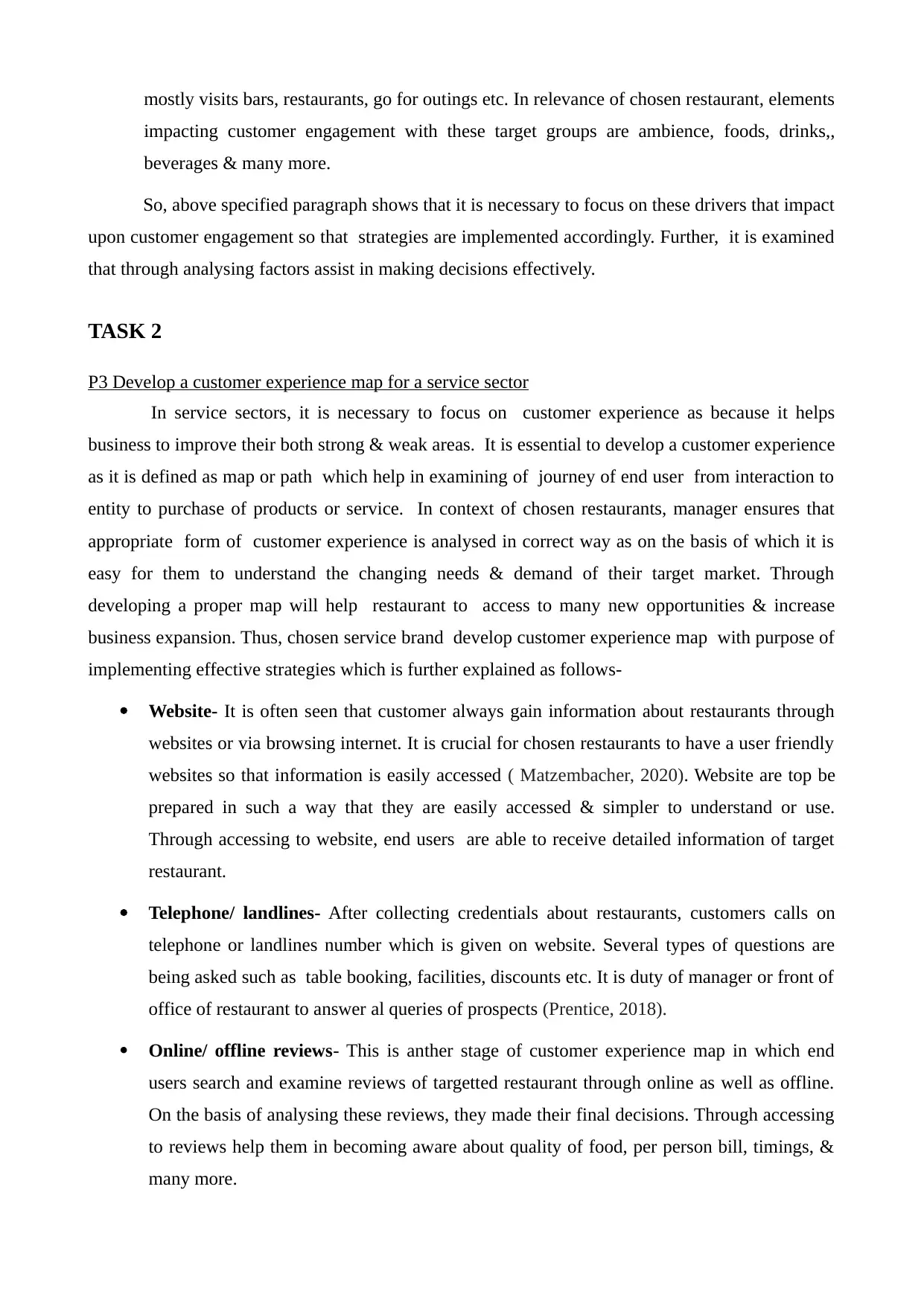
mostly visits bars, restaurants, go for outings etc. In relevance of chosen restaurant, elements
impacting customer engagement with these target groups are ambience, foods, drinks,,
beverages & many more.
So, above specified paragraph shows that it is necessary to focus on these drivers that impact
upon customer engagement so that strategies are implemented accordingly. Further, it is examined
that through analysing factors assist in making decisions effectively.
TASK 2
P3 Develop a customer experience map for a service sector
In service sectors, it is necessary to focus on customer experience as because it helps
business to improve their both strong & weak areas. It is essential to develop a customer experience
as it is defined as map or path which help in examining of journey of end user from interaction to
entity to purchase of products or service. In context of chosen restaurants, manager ensures that
appropriate form of customer experience is analysed in correct way as on the basis of which it is
easy for them to understand the changing needs & demand of their target market. Through
developing a proper map will help restaurant to access to many new opportunities & increase
business expansion. Thus, chosen service brand develop customer experience map with purpose of
implementing effective strategies which is further explained as follows-
Website- It is often seen that customer always gain information about restaurants through
websites or via browsing internet. It is crucial for chosen restaurants to have a user friendly
websites so that information is easily accessed ( Matzembacher, 2020). Website are top be
prepared in such a way that they are easily accessed & simpler to understand or use.
Through accessing to website, end users are able to receive detailed information of target
restaurant.
Telephone/ landlines- After collecting credentials about restaurants, customers calls on
telephone or landlines number which is given on website. Several types of questions are
being asked such as table booking, facilities, discounts etc. It is duty of manager or front of
office of restaurant to answer al queries of prospects (Prentice, 2018).
Online/ offline reviews- This is anther stage of customer experience map in which end
users search and examine reviews of targetted restaurant through online as well as offline.
On the basis of analysing these reviews, they made their final decisions. Through accessing
to reviews help them in becoming aware about quality of food, per person bill, timings, &
many more.
impacting customer engagement with these target groups are ambience, foods, drinks,,
beverages & many more.
So, above specified paragraph shows that it is necessary to focus on these drivers that impact
upon customer engagement so that strategies are implemented accordingly. Further, it is examined
that through analysing factors assist in making decisions effectively.
TASK 2
P3 Develop a customer experience map for a service sector
In service sectors, it is necessary to focus on customer experience as because it helps
business to improve their both strong & weak areas. It is essential to develop a customer experience
as it is defined as map or path which help in examining of journey of end user from interaction to
entity to purchase of products or service. In context of chosen restaurants, manager ensures that
appropriate form of customer experience is analysed in correct way as on the basis of which it is
easy for them to understand the changing needs & demand of their target market. Through
developing a proper map will help restaurant to access to many new opportunities & increase
business expansion. Thus, chosen service brand develop customer experience map with purpose of
implementing effective strategies which is further explained as follows-
Website- It is often seen that customer always gain information about restaurants through
websites or via browsing internet. It is crucial for chosen restaurants to have a user friendly
websites so that information is easily accessed ( Matzembacher, 2020). Website are top be
prepared in such a way that they are easily accessed & simpler to understand or use.
Through accessing to website, end users are able to receive detailed information of target
restaurant.
Telephone/ landlines- After collecting credentials about restaurants, customers calls on
telephone or landlines number which is given on website. Several types of questions are
being asked such as table booking, facilities, discounts etc. It is duty of manager or front of
office of restaurant to answer al queries of prospects (Prentice, 2018).
Online/ offline reviews- This is anther stage of customer experience map in which end
users search and examine reviews of targetted restaurant through online as well as offline.
On the basis of analysing these reviews, they made their final decisions. Through accessing
to reviews help them in becoming aware about quality of food, per person bill, timings, &
many more.
⊘ This is a preview!⊘
Do you want full access?
Subscribe today to unlock all pages.

Trusted by 1+ million students worldwide
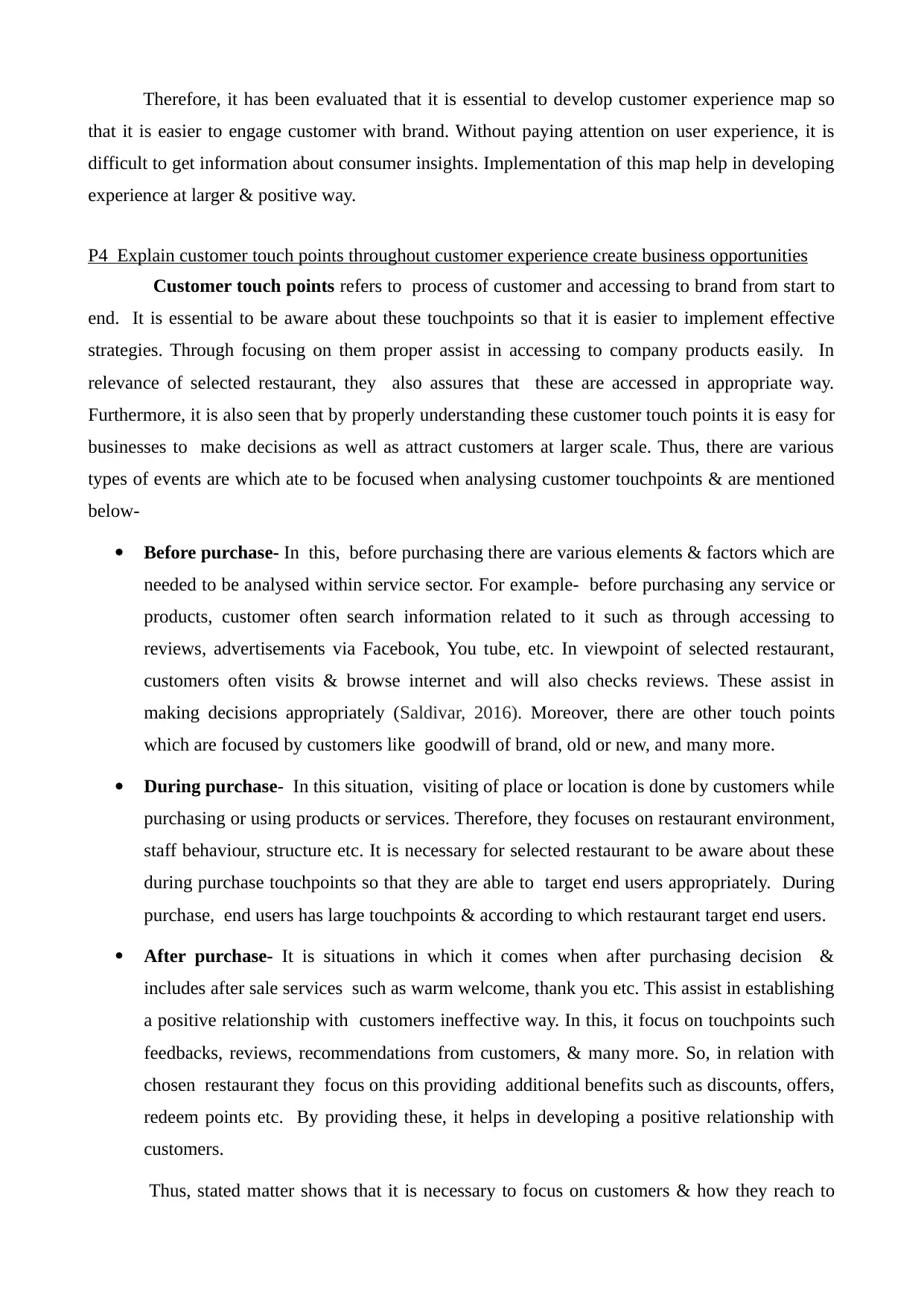
Therefore, it has been evaluated that it is essential to develop customer experience map so
that it is easier to engage customer with brand. Without paying attention on user experience, it is
difficult to get information about consumer insights. Implementation of this map help in developing
experience at larger & positive way.
P4 Explain customer touch points throughout customer experience create business opportunities
Customer touch points refers to process of customer and accessing to brand from start to
end. It is essential to be aware about these touchpoints so that it is easier to implement effective
strategies. Through focusing on them proper assist in accessing to company products easily. In
relevance of selected restaurant, they also assures that these are accessed in appropriate way.
Furthermore, it is also seen that by properly understanding these customer touch points it is easy for
businesses to make decisions as well as attract customers at larger scale. Thus, there are various
types of events are which ate to be focused when analysing customer touchpoints & are mentioned
below-
Before purchase- In this, before purchasing there are various elements & factors which are
needed to be analysed within service sector. For example- before purchasing any service or
products, customer often search information related to it such as through accessing to
reviews, advertisements via Facebook, You tube, etc. In viewpoint of selected restaurant,
customers often visits & browse internet and will also checks reviews. These assist in
making decisions appropriately (Saldivar, 2016). Moreover, there are other touch points
which are focused by customers like goodwill of brand, old or new, and many more.
During purchase- In this situation, visiting of place or location is done by customers while
purchasing or using products or services. Therefore, they focuses on restaurant environment,
staff behaviour, structure etc. It is necessary for selected restaurant to be aware about these
during purchase touchpoints so that they are able to target end users appropriately. During
purchase, end users has large touchpoints & according to which restaurant target end users.
After purchase- It is situations in which it comes when after purchasing decision &
includes after sale services such as warm welcome, thank you etc. This assist in establishing
a positive relationship with customers ineffective way. In this, it focus on touchpoints such
feedbacks, reviews, recommendations from customers, & many more. So, in relation with
chosen restaurant they focus on this providing additional benefits such as discounts, offers,
redeem points etc. By providing these, it helps in developing a positive relationship with
customers.
Thus, stated matter shows that it is necessary to focus on customers & how they reach to
that it is easier to engage customer with brand. Without paying attention on user experience, it is
difficult to get information about consumer insights. Implementation of this map help in developing
experience at larger & positive way.
P4 Explain customer touch points throughout customer experience create business opportunities
Customer touch points refers to process of customer and accessing to brand from start to
end. It is essential to be aware about these touchpoints so that it is easier to implement effective
strategies. Through focusing on them proper assist in accessing to company products easily. In
relevance of selected restaurant, they also assures that these are accessed in appropriate way.
Furthermore, it is also seen that by properly understanding these customer touch points it is easy for
businesses to make decisions as well as attract customers at larger scale. Thus, there are various
types of events are which ate to be focused when analysing customer touchpoints & are mentioned
below-
Before purchase- In this, before purchasing there are various elements & factors which are
needed to be analysed within service sector. For example- before purchasing any service or
products, customer often search information related to it such as through accessing to
reviews, advertisements via Facebook, You tube, etc. In viewpoint of selected restaurant,
customers often visits & browse internet and will also checks reviews. These assist in
making decisions appropriately (Saldivar, 2016). Moreover, there are other touch points
which are focused by customers like goodwill of brand, old or new, and many more.
During purchase- In this situation, visiting of place or location is done by customers while
purchasing or using products or services. Therefore, they focuses on restaurant environment,
staff behaviour, structure etc. It is necessary for selected restaurant to be aware about these
during purchase touchpoints so that they are able to target end users appropriately. During
purchase, end users has large touchpoints & according to which restaurant target end users.
After purchase- It is situations in which it comes when after purchasing decision &
includes after sale services such as warm welcome, thank you etc. This assist in establishing
a positive relationship with customers ineffective way. In this, it focus on touchpoints such
feedbacks, reviews, recommendations from customers, & many more. So, in relation with
chosen restaurant they focus on this providing additional benefits such as discounts, offers,
redeem points etc. By providing these, it helps in developing a positive relationship with
customers.
Thus, stated matter shows that it is necessary to focus on customers & how they reach to
Paraphrase This Document
Need a fresh take? Get an instant paraphrase of this document with our AI Paraphraser
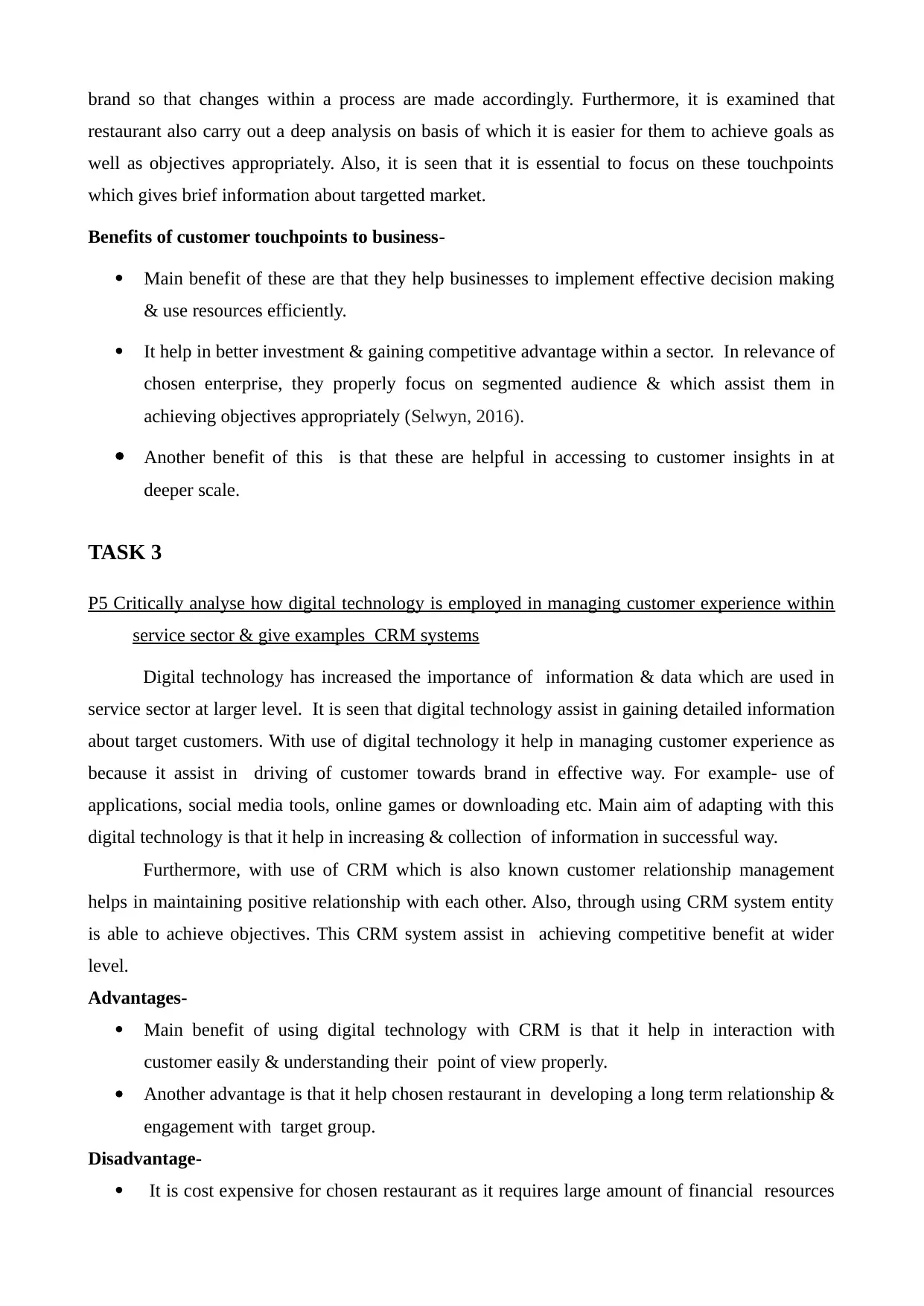
brand so that changes within a process are made accordingly. Furthermore, it is examined that
restaurant also carry out a deep analysis on basis of which it is easier for them to achieve goals as
well as objectives appropriately. Also, it is seen that it is essential to focus on these touchpoints
which gives brief information about targetted market.
Benefits of customer touchpoints to business-
Main benefit of these are that they help businesses to implement effective decision making
& use resources efficiently.
It help in better investment & gaining competitive advantage within a sector. In relevance of
chosen enterprise, they properly focus on segmented audience & which assist them in
achieving objectives appropriately (Selwyn, 2016).
Another benefit of this is that these are helpful in accessing to customer insights in at
deeper scale.
TASK 3
P5 Critically analyse how digital technology is employed in managing customer experience within
service sector & give examples CRM systems
Digital technology has increased the importance of information & data which are used in
service sector at larger level. It is seen that digital technology assist in gaining detailed information
about target customers. With use of digital technology it help in managing customer experience as
because it assist in driving of customer towards brand in effective way. For example- use of
applications, social media tools, online games or downloading etc. Main aim of adapting with this
digital technology is that it help in increasing & collection of information in successful way.
Furthermore, with use of CRM which is also known customer relationship management
helps in maintaining positive relationship with each other. Also, through using CRM system entity
is able to achieve objectives. This CRM system assist in achieving competitive benefit at wider
level.
Advantages-
Main benefit of using digital technology with CRM is that it help in interaction with
customer easily & understanding their point of view properly.
Another advantage is that it help chosen restaurant in developing a long term relationship &
engagement with target group.
Disadvantage-
It is cost expensive for chosen restaurant as it requires large amount of financial resources
restaurant also carry out a deep analysis on basis of which it is easier for them to achieve goals as
well as objectives appropriately. Also, it is seen that it is essential to focus on these touchpoints
which gives brief information about targetted market.
Benefits of customer touchpoints to business-
Main benefit of these are that they help businesses to implement effective decision making
& use resources efficiently.
It help in better investment & gaining competitive advantage within a sector. In relevance of
chosen enterprise, they properly focus on segmented audience & which assist them in
achieving objectives appropriately (Selwyn, 2016).
Another benefit of this is that these are helpful in accessing to customer insights in at
deeper scale.
TASK 3
P5 Critically analyse how digital technology is employed in managing customer experience within
service sector & give examples CRM systems
Digital technology has increased the importance of information & data which are used in
service sector at larger level. It is seen that digital technology assist in gaining detailed information
about target customers. With use of digital technology it help in managing customer experience as
because it assist in driving of customer towards brand in effective way. For example- use of
applications, social media tools, online games or downloading etc. Main aim of adapting with this
digital technology is that it help in increasing & collection of information in successful way.
Furthermore, with use of CRM which is also known customer relationship management
helps in maintaining positive relationship with each other. Also, through using CRM system entity
is able to achieve objectives. This CRM system assist in achieving competitive benefit at wider
level.
Advantages-
Main benefit of using digital technology with CRM is that it help in interaction with
customer easily & understanding their point of view properly.
Another advantage is that it help chosen restaurant in developing a long term relationship &
engagement with target group.
Disadvantage-
It is cost expensive for chosen restaurant as it requires large amount of financial resources

& time of technical staff.
To implement is effectively, selected restaurant has to carry out appropriate training &
development for employees so that it is used by them in correct way.
To implement is effectively, selected restaurant has to carry out appropriate training &
development for employees so that it is used by them in correct way.
⊘ This is a preview!⊘
Do you want full access?
Subscribe today to unlock all pages.

Trusted by 1+ million students worldwide
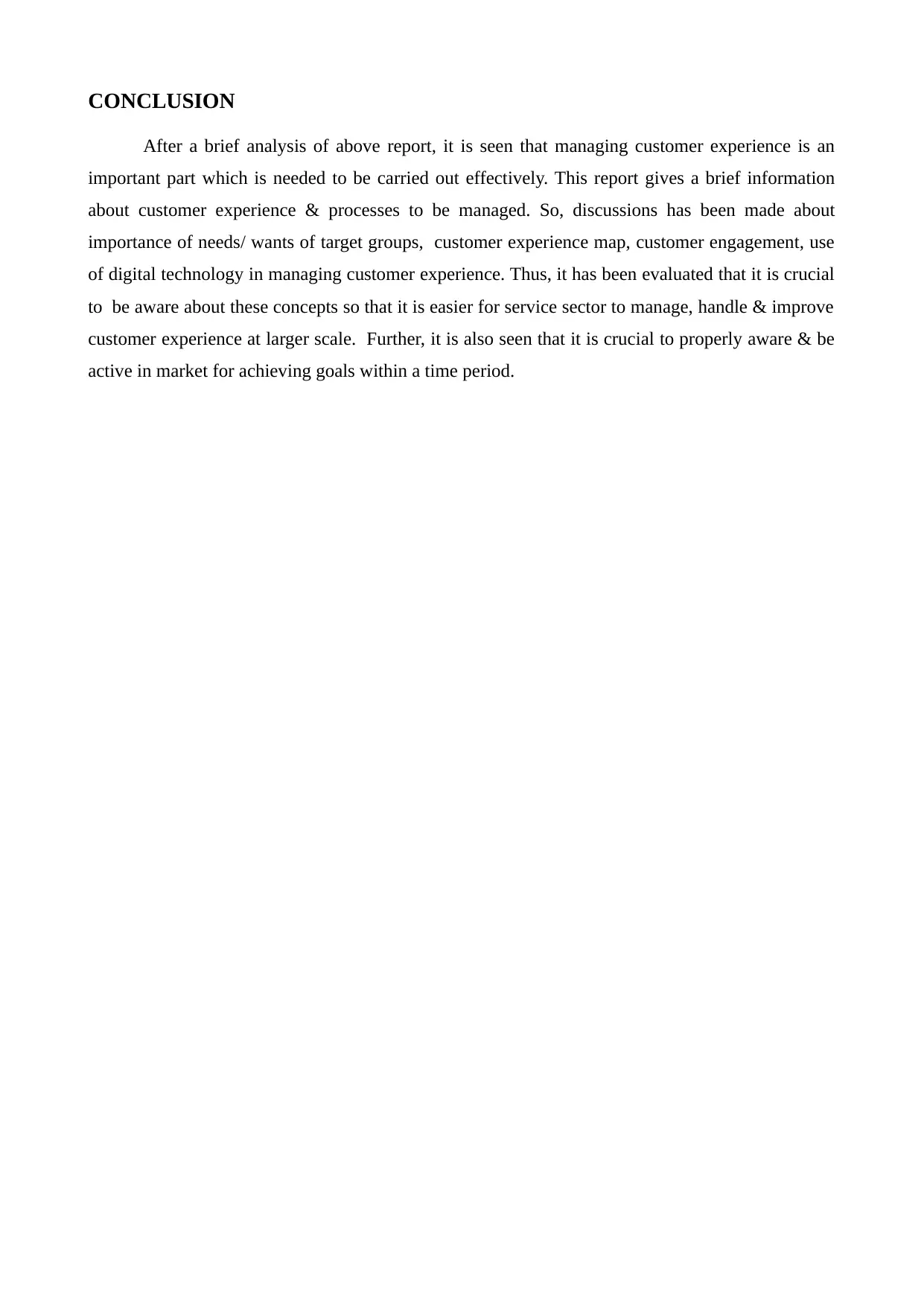
CONCLUSION
After a brief analysis of above report, it is seen that managing customer experience is an
important part which is needed to be carried out effectively. This report gives a brief information
about customer experience & processes to be managed. So, discussions has been made about
importance of needs/ wants of target groups, customer experience map, customer engagement, use
of digital technology in managing customer experience. Thus, it has been evaluated that it is crucial
to be aware about these concepts so that it is easier for service sector to manage, handle & improve
customer experience at larger scale. Further, it is also seen that it is crucial to properly aware & be
active in market for achieving goals within a time period.
After a brief analysis of above report, it is seen that managing customer experience is an
important part which is needed to be carried out effectively. This report gives a brief information
about customer experience & processes to be managed. So, discussions has been made about
importance of needs/ wants of target groups, customer experience map, customer engagement, use
of digital technology in managing customer experience. Thus, it has been evaluated that it is crucial
to be aware about these concepts so that it is easier for service sector to manage, handle & improve
customer experience at larger scale. Further, it is also seen that it is crucial to properly aware & be
active in market for achieving goals within a time period.
Paraphrase This Document
Need a fresh take? Get an instant paraphrase of this document with our AI Paraphraser
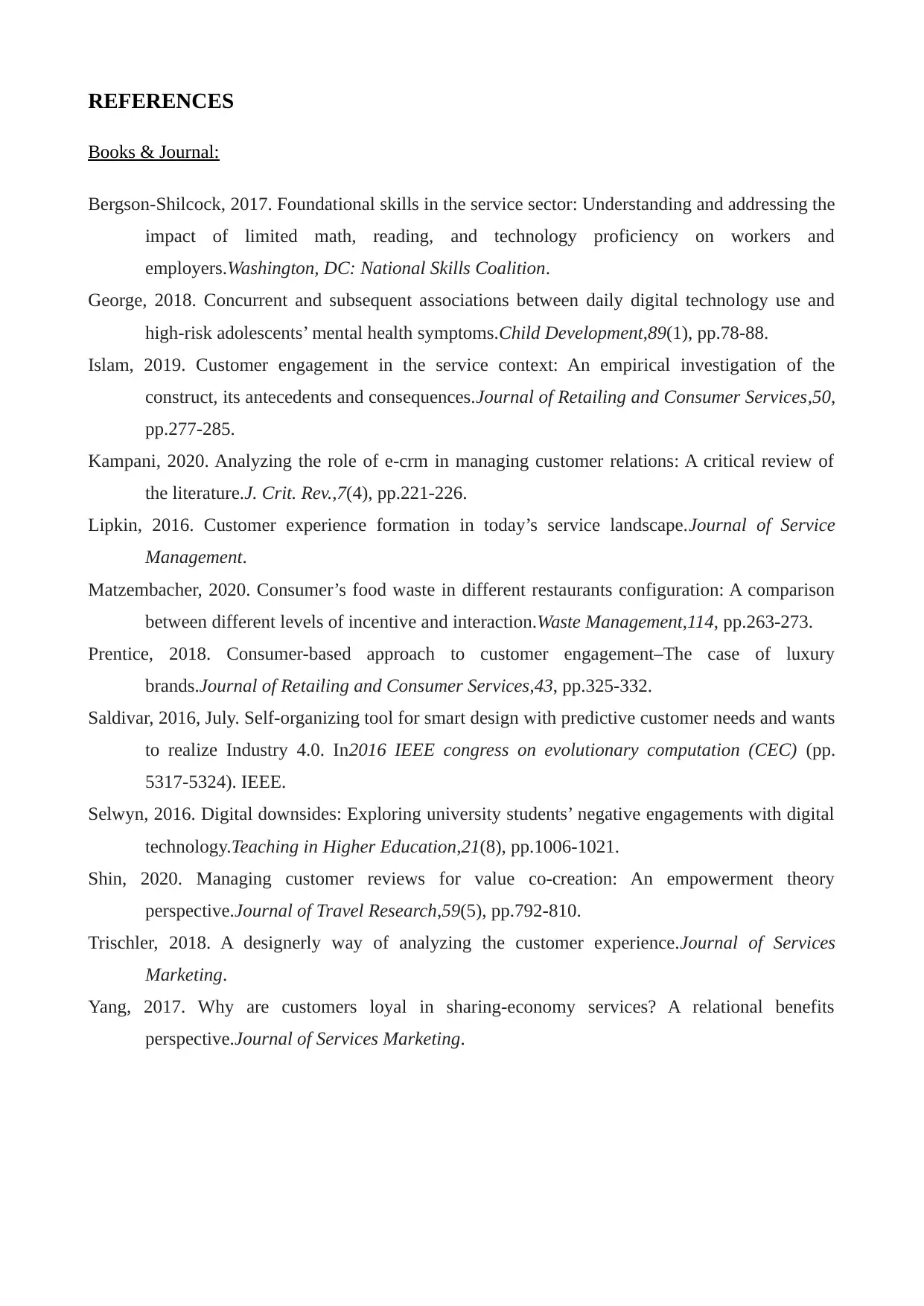
REFERENCES
Books & Journal:
Bergson-Shilcock, 2017. Foundational skills in the service sector: Understanding and addressing the
impact of limited math, reading, and technology proficiency on workers and
employers.Washington, DC: National Skills Coalition.
George, 2018. Concurrent and subsequent associations between daily digital technology use and
high‐risk adolescents’ mental health symptoms.Child Development,89(1), pp.78-88.
Islam, 2019. Customer engagement in the service context: An empirical investigation of the
construct, its antecedents and consequences.Journal of Retailing and Consumer Services,50,
pp.277-285.
Kampani, 2020. Analyzing the role of e-crm in managing customer relations: A critical review of
the literature.J. Crit. Rev.,7(4), pp.221-226.
Lipkin, 2016. Customer experience formation in today’s service landscape.Journal of Service
Management.
Matzembacher, 2020. Consumer’s food waste in different restaurants configuration: A comparison
between different levels of incentive and interaction.Waste Management,114, pp.263-273.
Prentice, 2018. Consumer-based approach to customer engagement–The case of luxury
brands.Journal of Retailing and Consumer Services,43, pp.325-332.
Saldivar, 2016, July. Self-organizing tool for smart design with predictive customer needs and wants
to realize Industry 4.0. In2016 IEEE congress on evolutionary computation (CEC) (pp.
5317-5324). IEEE.
Selwyn, 2016. Digital downsides: Exploring university students’ negative engagements with digital
technology.Teaching in Higher Education,21(8), pp.1006-1021.
Shin, 2020. Managing customer reviews for value co-creation: An empowerment theory
perspective.Journal of Travel Research,59(5), pp.792-810.
Trischler, 2018. A designerly way of analyzing the customer experience.Journal of Services
Marketing.
Yang, 2017. Why are customers loyal in sharing-economy services? A relational benefits
perspective.Journal of Services Marketing.
Books & Journal:
Bergson-Shilcock, 2017. Foundational skills in the service sector: Understanding and addressing the
impact of limited math, reading, and technology proficiency on workers and
employers.Washington, DC: National Skills Coalition.
George, 2018. Concurrent and subsequent associations between daily digital technology use and
high‐risk adolescents’ mental health symptoms.Child Development,89(1), pp.78-88.
Islam, 2019. Customer engagement in the service context: An empirical investigation of the
construct, its antecedents and consequences.Journal of Retailing and Consumer Services,50,
pp.277-285.
Kampani, 2020. Analyzing the role of e-crm in managing customer relations: A critical review of
the literature.J. Crit. Rev.,7(4), pp.221-226.
Lipkin, 2016. Customer experience formation in today’s service landscape.Journal of Service
Management.
Matzembacher, 2020. Consumer’s food waste in different restaurants configuration: A comparison
between different levels of incentive and interaction.Waste Management,114, pp.263-273.
Prentice, 2018. Consumer-based approach to customer engagement–The case of luxury
brands.Journal of Retailing and Consumer Services,43, pp.325-332.
Saldivar, 2016, July. Self-organizing tool for smart design with predictive customer needs and wants
to realize Industry 4.0. In2016 IEEE congress on evolutionary computation (CEC) (pp.
5317-5324). IEEE.
Selwyn, 2016. Digital downsides: Exploring university students’ negative engagements with digital
technology.Teaching in Higher Education,21(8), pp.1006-1021.
Shin, 2020. Managing customer reviews for value co-creation: An empowerment theory
perspective.Journal of Travel Research,59(5), pp.792-810.
Trischler, 2018. A designerly way of analyzing the customer experience.Journal of Services
Marketing.
Yang, 2017. Why are customers loyal in sharing-economy services? A relational benefits
perspective.Journal of Services Marketing.
1 out of 11
Related Documents
Your All-in-One AI-Powered Toolkit for Academic Success.
+13062052269
info@desklib.com
Available 24*7 on WhatsApp / Email
![[object Object]](/_next/static/media/star-bottom.7253800d.svg)
Unlock your academic potential
Copyright © 2020–2025 A2Z Services. All Rights Reserved. Developed and managed by ZUCOL.





